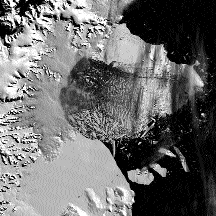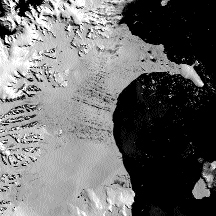Geotimes

Highlights
Glaciology
Terence Hughes
The year 2001 was bracketed by two volumes dealing with the climate record
contained in ice cores: The Two Mile Time Machine (2000) by Richard Alley
and The Ice Chronicles (2002) by Paul Mayewski and Frank White. These
serve as bookends for the first International Symposium on Ice Cores and Climate
to be held in Greenland.The symposium took place in Kangerlussuaq last August
and was co-sponsored by the International Glaciological Society, the Danish
Natural Science Foundation, and the University of Copenhagen. 
 Topics
included the interpretation of ice-core records, comparison of results from
different ice cores, meteorology of air-snow transfer to improve ice-core interpretation,
comparison of ice-core records with other climate records, mass balance studies,
results from the Program for Arctic Regional Climate Assessment (PARCA), geophysical
and borehole measurements, and ice-flow rheology that influences ice-core interpretation.
Topics
included the interpretation of ice-core records, comparison of results from
different ice cores, meteorology of air-snow transfer to improve ice-core interpretation,
comparison of ice-core records with other climate records, mass balance studies,
results from the Program for Arctic Regional Climate Assessment (PARCA), geophysical
and borehole measurements, and ice-flow rheology that influences ice-core interpretation.
The northern section of
the Larsen B ice shelf, an ice mass on the eastern side of the Antarctic Peninsula,
collapsed earlier this year. These satellite images compiled from the Moderate
Resolution Imaging Spectrometer (MODIS), and analyzed at the University of Colorado's
National Snow and Ice Data Center, show that between Jan. 31 (left) and March
5 (right), the ice shelf lost about 1,255 square miles of area. Photo courtesy
of the National Snow and Ice Data Center
Antarctic research
In Antarctica, the year saw completion of the 2000-2001 leg of the United States
component of the International Trans-Antarctic Scientific Expeditions (ITASE)
and the beginning of the 2001-2002 leg, both near the ice divide of the West
Antarctic Ice Sheet. The ITASE traverses collect meteorological data, recover
200-to-500-year climate records from shallow ice cores, and measure surface
mass balance, elevation, and mean temperature; internal ice stratigraphy; and
subglacial topography. The 2001-2002 traverse collected the first comprehensive
data set for ice draining into Pine Island Bay on the Amundsen Sea flank of
the West Antarctic Ice Sheet, which comprises about one-third of the remaining
ice sheet and the site for future glaciological studies of the West Antarctic
Ice Sheet (WAIS) Initiative of the U.S. National Science Foundation.
The Eighth Annual WAIS Workshop was held in September 2001 near Sterling, Va.
Presentations focused on four questions:
- What is happening in the Pine Island Glacier and Thwaites Glacier sector
of the ice sheet that drains into Pine Island Bay?
- What is the Siple Dome ice core (lying between ice streams C and D and draining
into the Ross Ice Shelf) telling us about the last few thousand years in West
Antarctica?
- What is the U. S. component of ITASE (results of the 2000-2001 traverse)
revealing about the last few hundred years in West Antarctica?
- Regarding ice streams (which discharge about 90 percent of West Antarctic
ice), what have we learned about their patterns of starting and stopping?
Many presentations dealt with the inception of stream flow near the West Antarctic
ice divide for ice streams entering the Ross Ice Shelf, and several powerful
demonstrations explained how satellite remote-sensing technology is aiding these
investigations.
Julie Palias, NSF program manager for glaciology, announced that ice stream
B has been renamed Whillans Ice Stream, in honor of Ian Whillans, a pioneer
in Antarctic glaciology, who died in May 2001. His death occurred just over
a year after the glaciological community lost Dr. Akira Higashi, the dean of
Japanese glaciologists, in March 2000.
In his presentation of a three-dimensional look inside ice stream C, Hermann
Engelhardt distributed 3-D glasses at the start of his video journey down a
borehole. The camera showed entrapped air bubbles giving way to ice foliation
patterns and passing through a layer of refrozen basal ice charged with till
before revealing a glimpse of ice moving over the bed.
Several WAIS presentations were published in the Journal of Glaciology
in 2001. Notable among them was a paper by Eric Rignot showing that Thwaites
Glacier, like Pine Island Glacier, has a thinning ice drainage basin, rapid
ice-melting rates beneath its floating terminus, and a retreating grounding
line.
In another paper, J. Wellner, A. Lowe, S. Shipp, and J. Anderson described the
glacial geology of the West Antarctic continental shelf in the Ross, Amundsen,
and Bellingshausen seas in relation to Holocene gravitational collapse of the
West Antarctic Ice Sheet. Major episodes of ice-shelf disintegration in West
Antarctica during 2001 and 2002 are indications of ongoing collapse, especially
in Pine Island Bay.
AGU honors Barclay Kamb
At a special session of the American Geophysical Union's fall meeting, Barclay
Kamb of the California Institute of Technology was honored for his contributions
to our science. Kamb was introduced by his former student, Charles Raymond.
The two may be the first teacher-student pair ever to receive the Seligman Crystal,
the highest award of the International Glaciological Society.
Throughout his career, Kamb has consistently taken on the hardest tasks in glaciology:
from determining the low-temperature, high-pressure phases of ice -- including
intricacies of the hydrogen bond -- to drilling through Variegated Glacier (Alaska)
as it was surging, Columbia Glacier (Alaska) as it was disintegrating, and ice
streams B and C in Antarctica. He has excelled in all aspects of glaciology,
from laboratory experiments and instrument design to drilling technology, field
studies, and theoretical investigations.
Douglas MacAyeal, past chief editor of the Journal of Glaciology, recalled
an earlier AGU meeting where Barclay Kamb spoke on a geophysical/tectonic problem
unrelated to glaciology. After Kamb's talk, MacAyeal overheard the following
exchange between two geophysicists:
"Who is Barclay Kamb? That was the best talk I've ever heard!"
"He's a glaciologist."
"A glaciologist? What a waste of a first-class mind!"
It wasn't wasted.
Back to index
Hughes is a professor in the
Department of Geological Sciences and Institute for Quaternary and Climate Studies
of the Bryand Global Sciences Center at the University of Maine. His glaciological
research has been in Antarctica and Greenland, and he is the author of Ice
Sheets (Oxford University Press, 1998). E-mail.

 Topics
included the interpretation of ice-core records, comparison of results from
different ice cores, meteorology of air-snow transfer to improve ice-core interpretation,
comparison of ice-core records with other climate records, mass balance studies,
results from the Program for Arctic Regional Climate Assessment (PARCA), geophysical
and borehole measurements, and ice-flow rheology that influences ice-core interpretation.
Topics
included the interpretation of ice-core records, comparison of results from
different ice cores, meteorology of air-snow transfer to improve ice-core interpretation,
comparison of ice-core records with other climate records, mass balance studies,
results from the Program for Arctic Regional Climate Assessment (PARCA), geophysical
and borehole measurements, and ice-flow rheology that influences ice-core interpretation.
